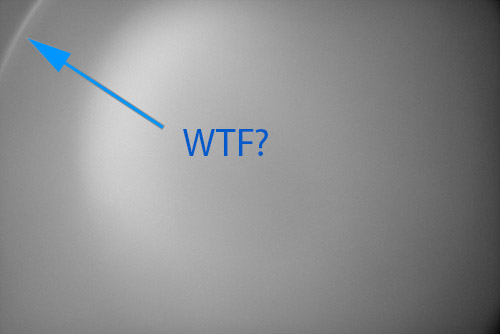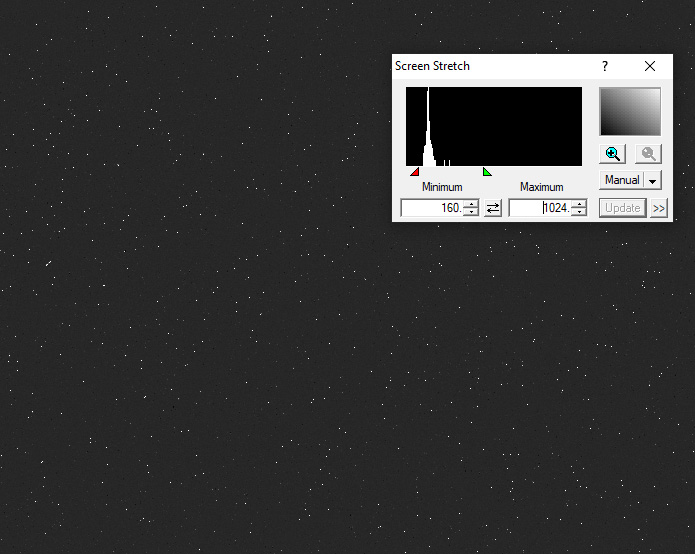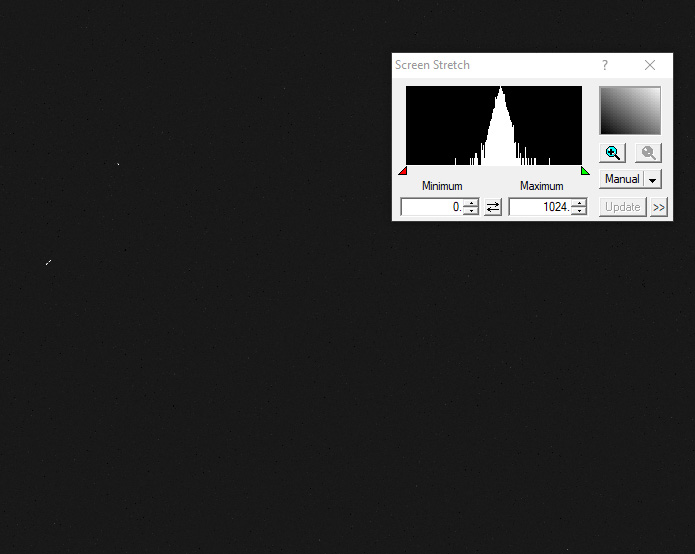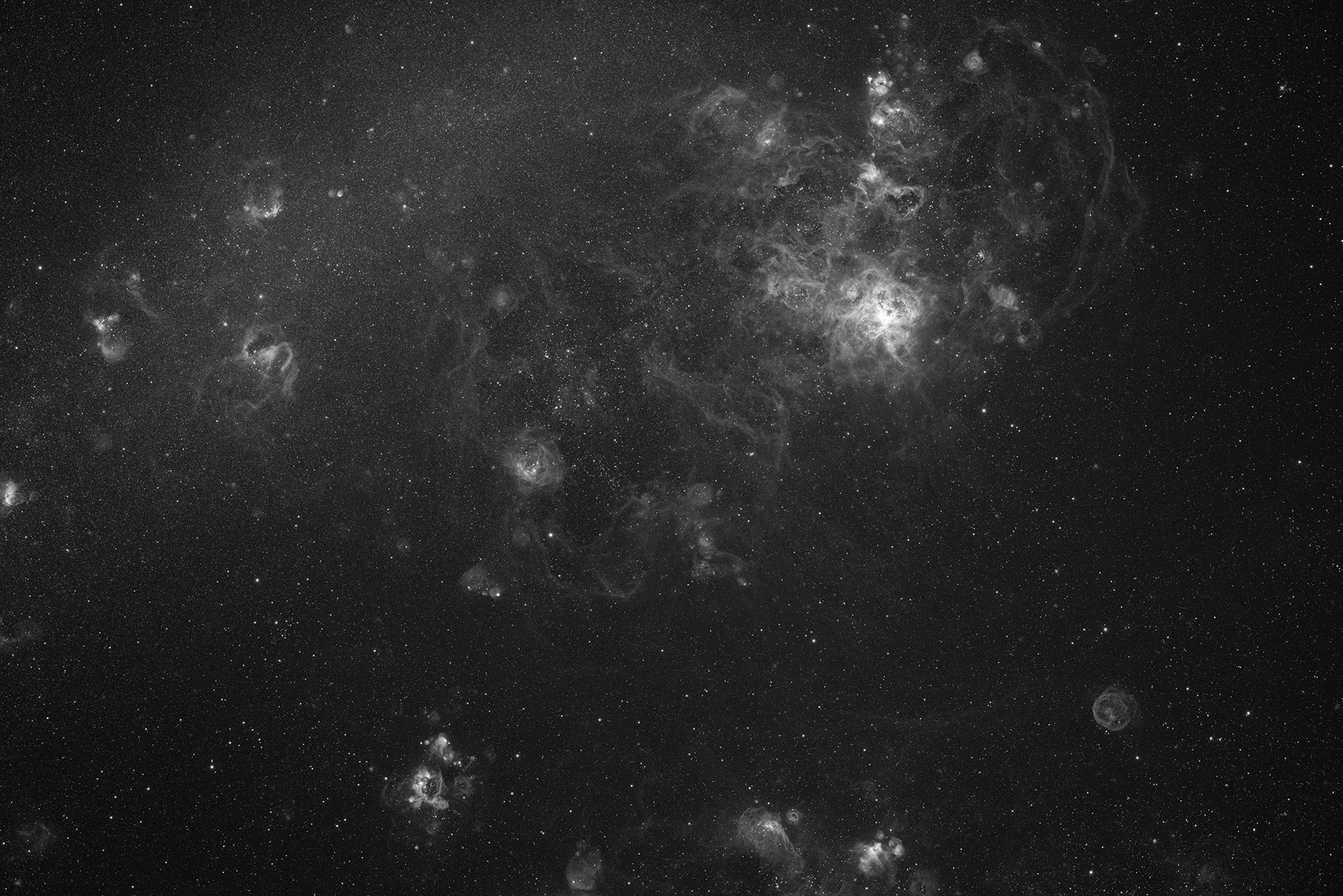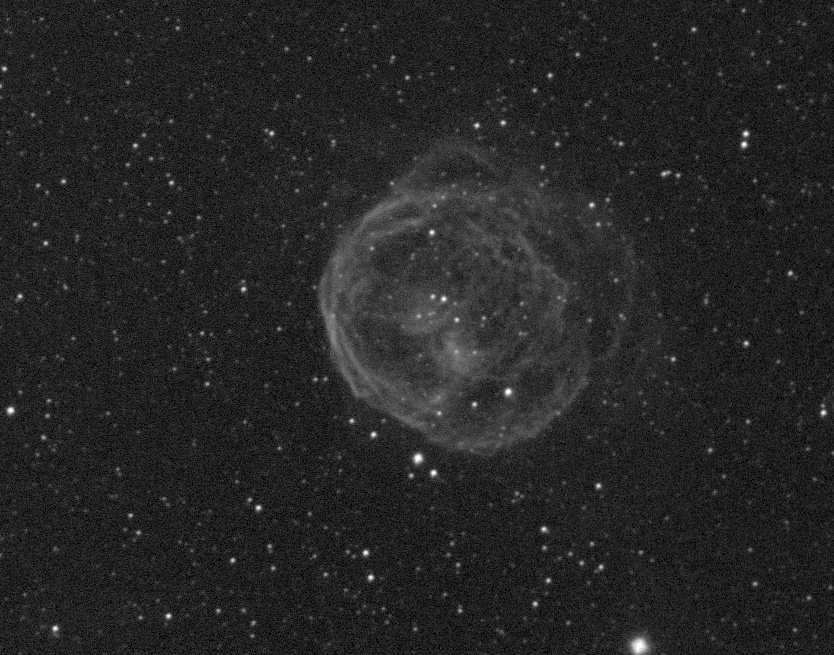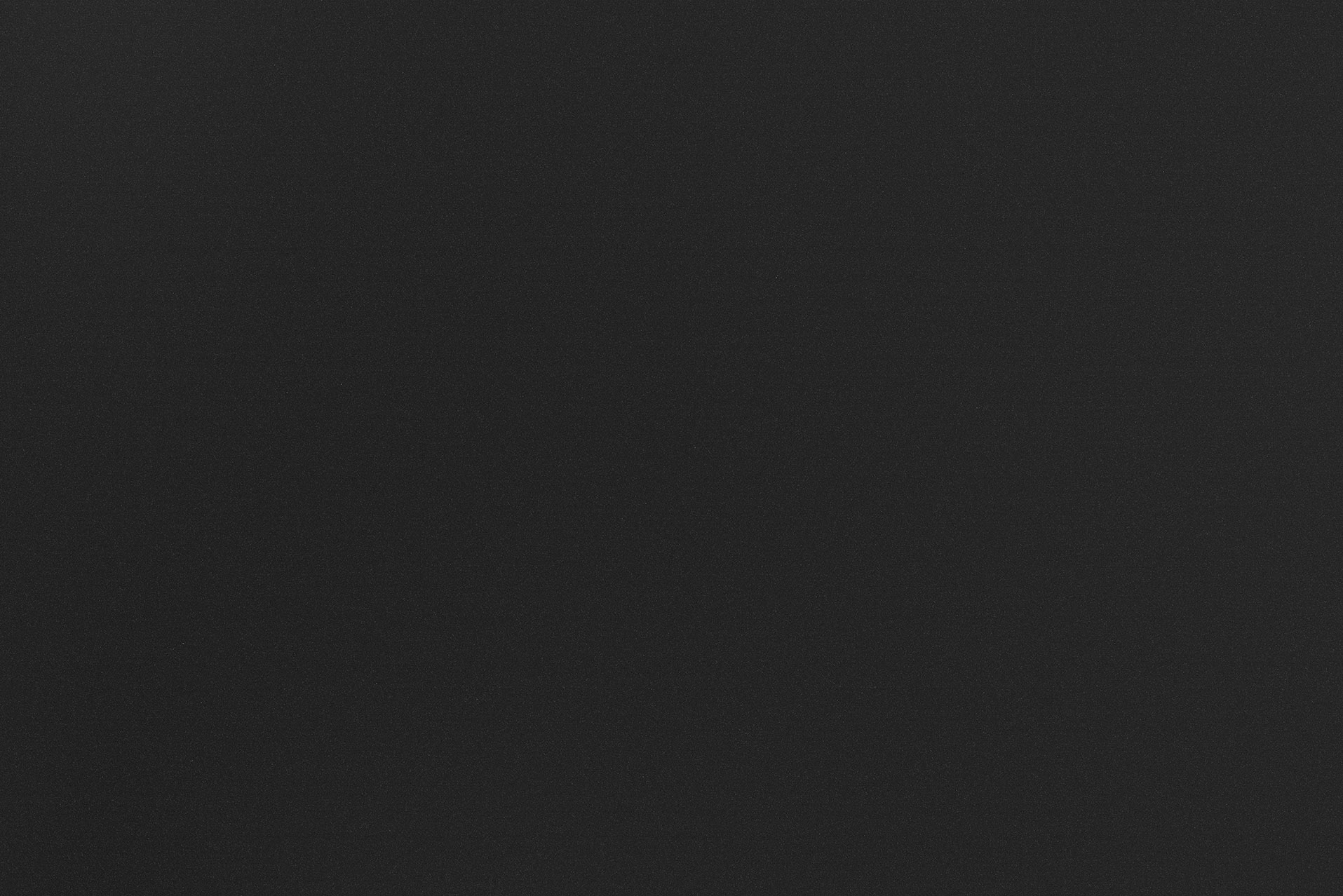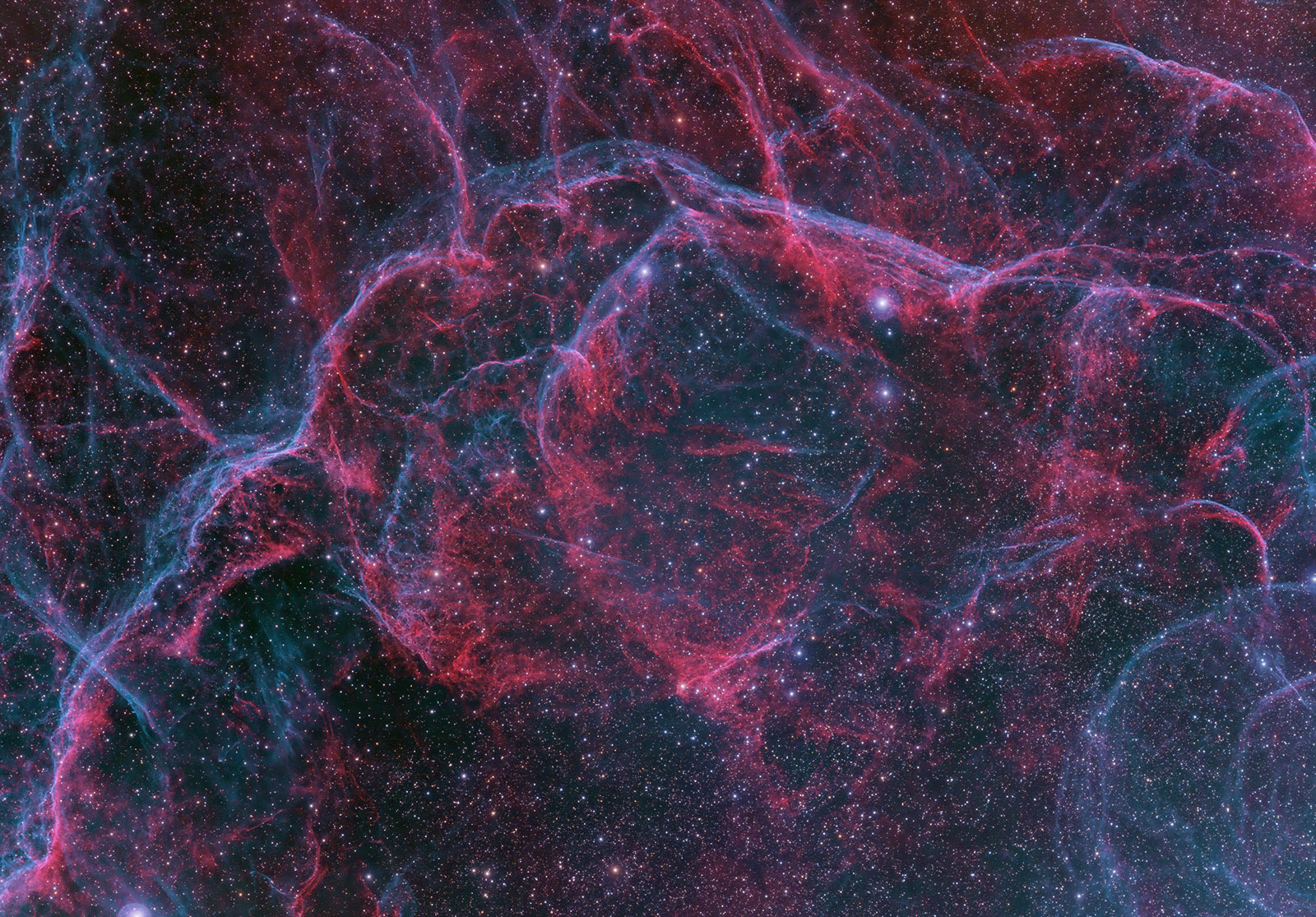Below The QHY600M PHOTO-L with 7 position CFW, OAG and guide cam: total weight 2.1kg
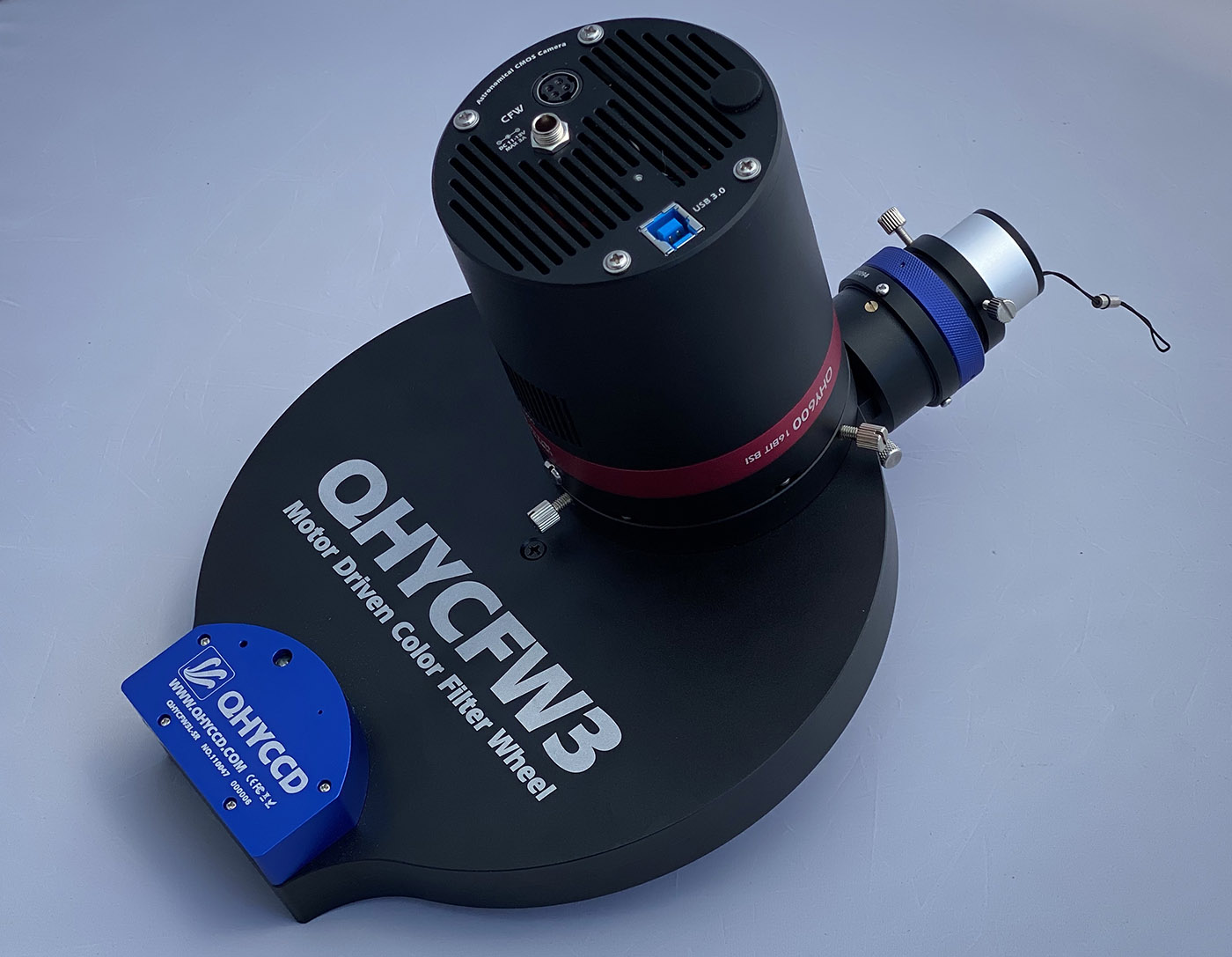
Below The QHY600M PHOTO-L sports a shotrer case which holds the 35mm format Sony IMX455 BSI CMOS sensor
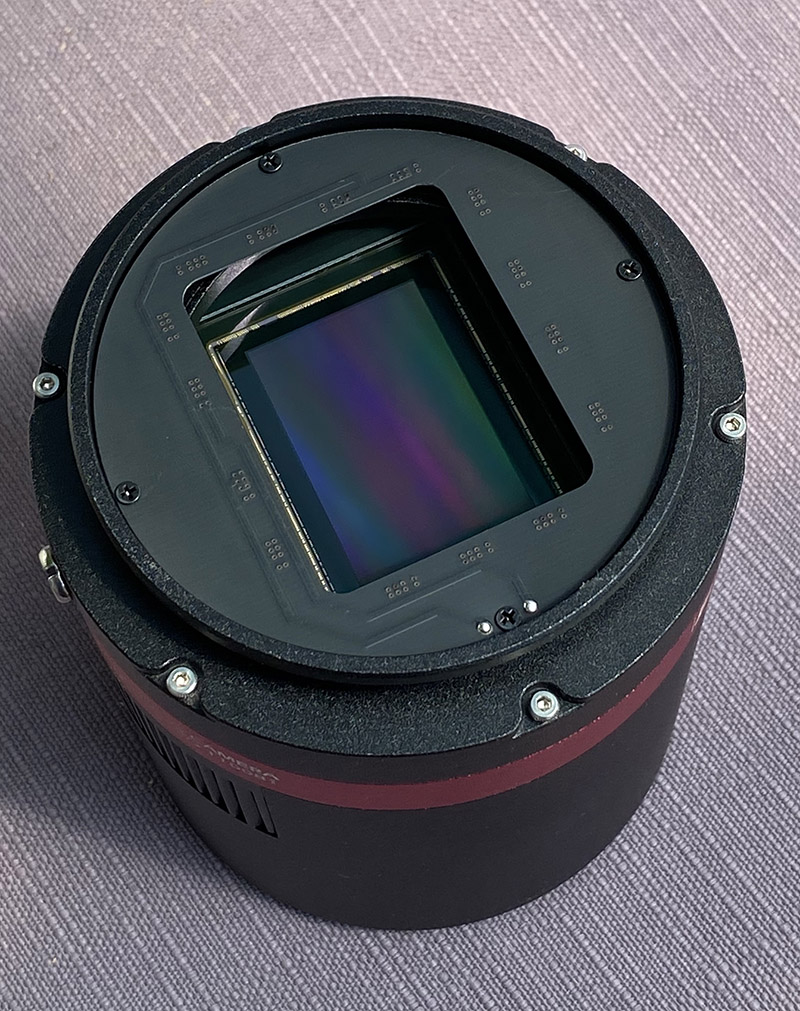
The 7x 50mm round filter set is secured into the CFW3 via 21 M2 bolts and 63 fibre washers and shims.
Pictured is the first assembly interation using only washers...it was not very successful.
The shims are required to pack the washer up to the top of the filters.
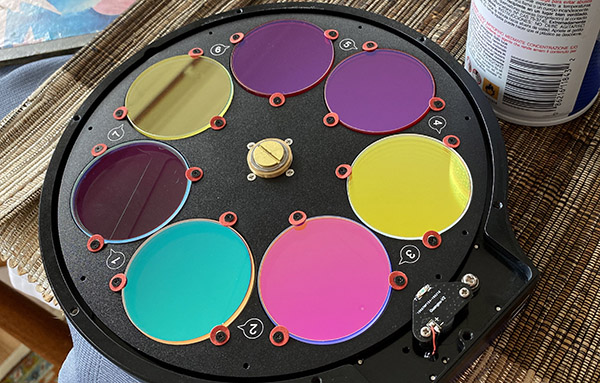
Below two 12x 300second SD stacked exposures
through a Takahashi FSQ106 and Baader 7nm h-alpha filter.
Dark and flat calibrated.
The 9 micron CCD pixels clearly undersample the stars in the image
but shows the nebulosity very well with a clean background.
The 3.76 micron IMX455 sensor better samples the data and resolves faint background stars
The higher noise floor of the CMOS sensor is also evident.
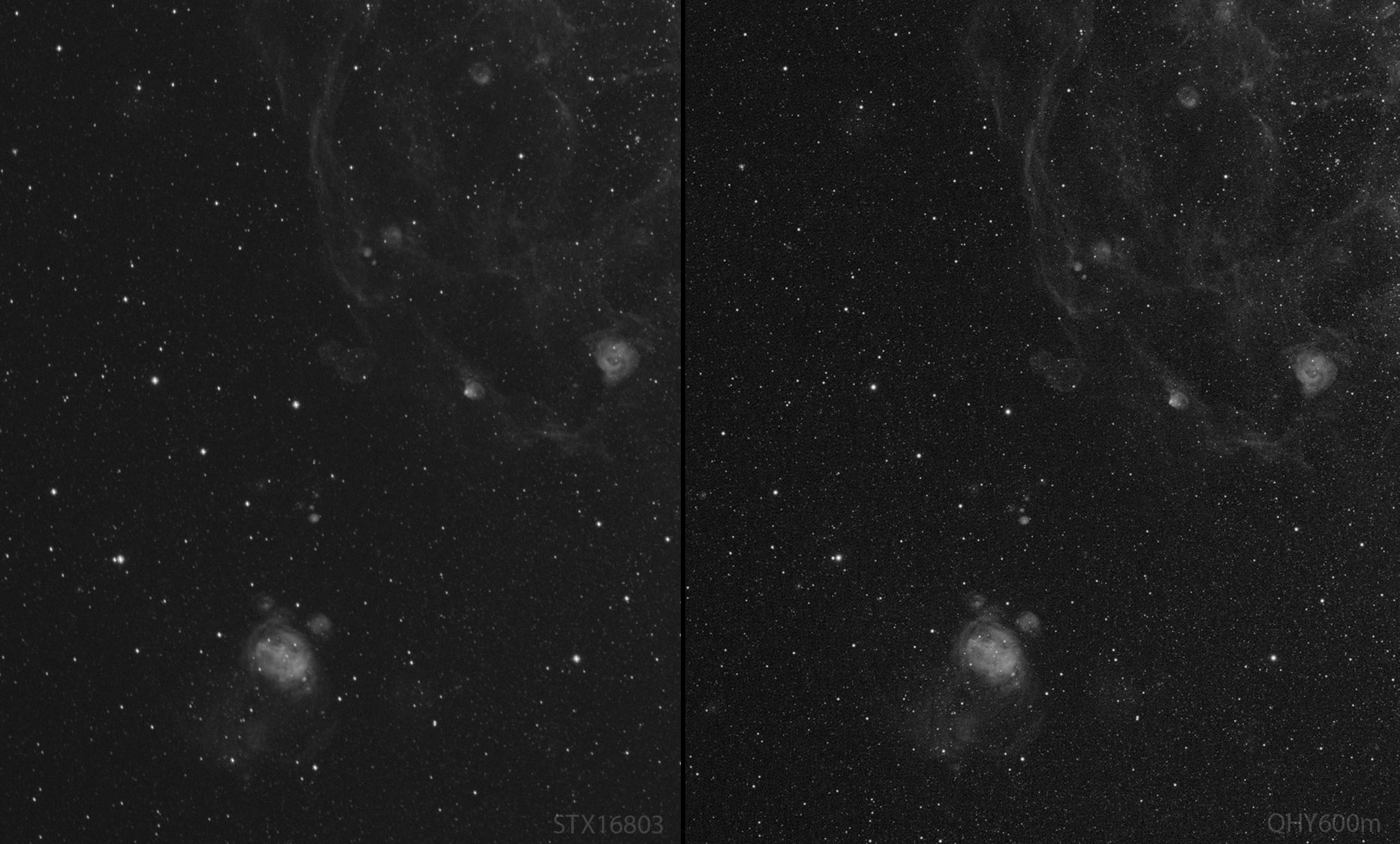
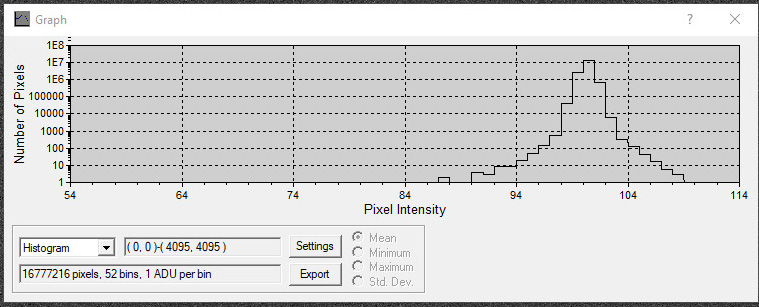
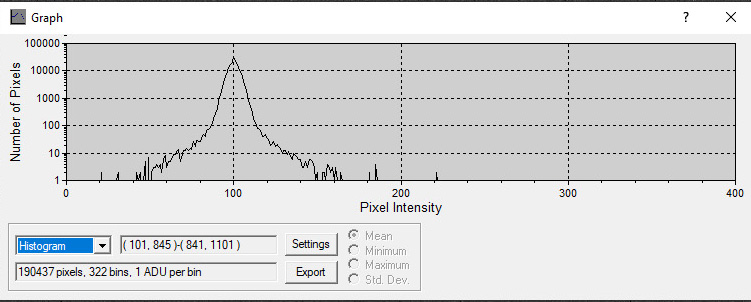
The above two graphs are of five median combined dark calibrated frames from
a KAF16803 CCD (upper graph) and the Sony IMX455 (lower graph) .
The bulk of the background pixel values in the
CCD image range
approximately 8 ADU counts.
The CMOS sensor has a range of around 100 ADU counts
these outlier hot and dark pixels are also evident in the enlarged croped dark frames below
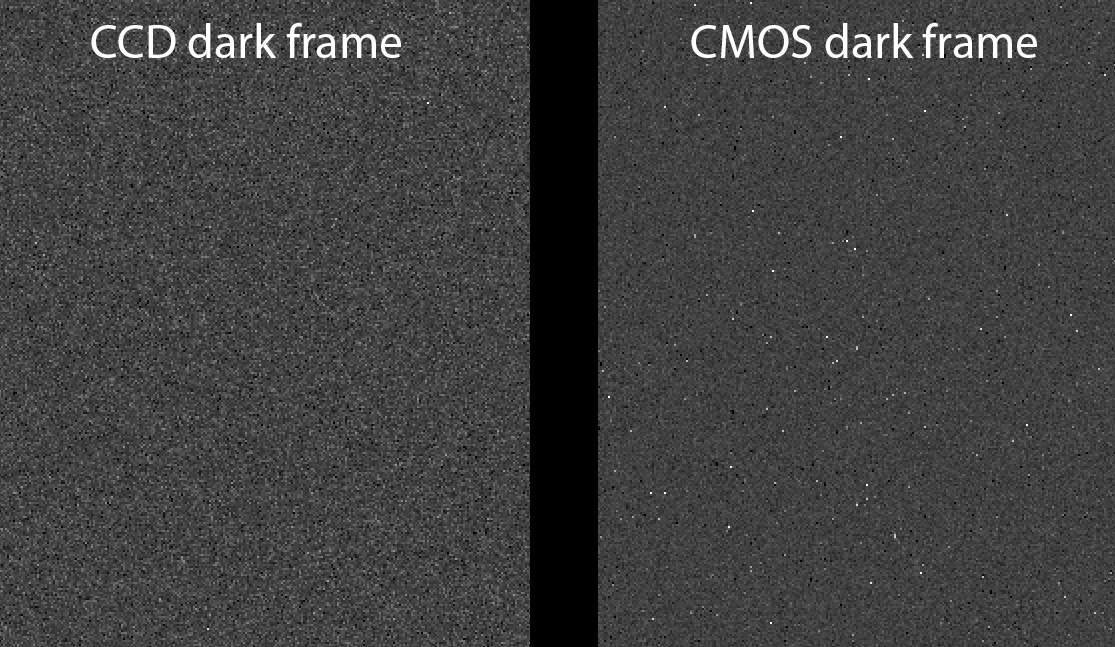
I have been coveting The QHY600m camera for a while now, and despite mixed reviews, decided it was high time I test the brave new world of BSI CMOS sensors first hand.
The SONY IMX455 sensor on which the camera is based has a 9576 x 6388 3.76 micron pixel array, i.e. 60 megapixels. Read noise is quoted as low as 1 electron and full well capacity typically at 51ke-. Unsurprisingly each 16bit image file is some 120Mb in size.Processing and storing copious data from this camera will be problematic for users with older PC’s. That said, I recently upgraded my desktop machine to 10th generation mulitcore processor, which programs like PixInsight take full advantage of. That plus a 24TB NAS drive to store the mountains of data this camera produces. With new PC hardware I found subsequent processing of the QHY image files to be remarkably quick and efficient…but it did come with additional and significant financial cost. Unless your PC can processes gigabytes of data without much fuss, it would be prudent to factor in that cost before you take the IMX455 plunge.
Things I did not like:1) Lack of and/or cryptic documentation. I ordered a camera plus filter-wheel and off-axis guider kit. All that plus numerous spacers, bolts, screws and shims arrived in three boxes but have you wondering how on earth does all this go together? Not even a basic quick-start card/sheet is supplied to quickly tell you what goes where.
Most, but not all information, is on the QHY website, but what is there is not well organised. The required drivers and software are also web delivered. Given this camera is not exactly cheap, a USB stick with a kernel of the required software and documentation (something that many other manufacturers supply) is glaringly absent.
2) QHY’s native EZCAP software is stable and it works. But apart from testing the camera’s functions it does not do much else. Third party solutions such as Firecapture, Sharpcap, NINA and my personal gold-standard MaxImCCD are needed to do any serious imaging sequences.That said, QHY’s ASCOM drivers are excellent.
MaxImCCD happily connected with the camera, filterwheel and guider. Downloads were blisteringly fast: 3 seconds or so for full resolution. Sub-frame images for focusing appear in almost real-time.
3) Mechanical fit and finish is worth mentioning. The camera head “plugs” into a semi bayonet fitting attached to the filter-wheel. The assembly is secured by three grub screws. It is not a precision fit and has some lateral play. The chrome grub screws are not Delrin tipped and will mar the camera on first use. I wrapped some plumber’s Teflon tape around the camera fitting to mitigate this. Yet the power supply comes with a screw-collared connector, a nice touch that makes you wonder why other fittings were skimped on. The camera supplies both power and control through a supplied cable to the CFW, hence only two USB cables need to be connected for the camera and guider.
Moving onto the seven position CFW3 filter-wheel : to fit the filters you are provided with 6 bags of washers, shims and tiny bolts. To fit seven filters you end up using 3 washers, 3 bolts and six shims per filter. That’s 91 pieces to load a filter set!! Sadly when you are done, the fit is pretty agricultural. I have another CFW that uses a single filter cover-plate that perfectly secures seven filters with 9 hex bolts. …if only QHY engineering was so elegant..... Happily there is a third party solution offering 3D printed filter mask sets, that make installing and removing filters a trivial task, for about $10.
The off-axis guider is functional but the guide cam is secured again by three chrome grub screws rather than delrin or a non-marring compression collar. It does have a non-rotating helical focuser for the guide camera, again a very nice inclusion, hence why skimp by using cheap grub screws?The above quibbles aside, despite a lack of engineering elegance, it all works fine. It was also satisfying to see both the guider and main camera come to focus with the recommended spacers.
Fully assembled the camera, CFW and OAG (with guide-cam) weigh in at 2.1 kilograms. Given my STX16803 with FW7 and external guider came in at a whopping 4.9 kilograms! The QHY system is far less taxing on focusers and connectors.
Connecting the camera to the host PC was seamless. Just plug in the USB3.0 cable, connect the power cable and power-up. Unlike smaller QHY cameras that obtain power from the USB cable, the QHY600 requires DC power to function. A universal AC/DC power pack is supplied with the camera, however the AC plug was for USA sockets. It was replaced with an Australian wall socket compatible plug. Once connected to the host PC you can set readout modes, binning and sensor temperature with the software of your choice.
From an ambient temperature of 18 degrees the cooler temperature set at -10c was reached in under two minutes…perhaps too quickly as thermal shock damage, while only hinted at in the QHY documentation, could easily occur. If you are wanting a deep delta-T, I’d suggest staging the cooling to avoid any future problems.
The stated delta-T limit of 35 degrees is a little optimistic, as with a delta-T of 30 degrees , the cooler power would typically settle at 80% or so.
Filter positioning is remarkably fast and bi-directional. The CFW does not use micron accurate positioning detents , but that said, flat field data did not show obvious signs of tell-tale post-calibration shadowing, due minor filter positioning errors. It's fast and works well.
While obtaining flat fields for each filter an interesting problem arose.
Only the red filter images showed a bizarre bright arc and banding that had no obvious cause. The most likely suspect appears to be poor baffling and/or internal reflections from a component in the camera imaging train. This was finally solved after replacing the QHY supplied filter washers with inexpensive 3D printed filter centering masks available from Buckeyestargazer
Mounting the camera onto a telescope is very straightforward via the supplied 2 inch nosepiece. I did have concerns about possible vignetting, but they proved unfounded. The nosepiece screws into a 54mm thread, which does afford a slightly wider aperture should you wish to attach the system with a custom threaded adapter. Focusing with the camera is a delight. With subframe download times well under a second, it is easy to nail focus without any automation.
I predict many who own telescopes fitted with adequate focusers will wanting decidedly more exacting focusers after using the QHY600. The 60Mp sensor is a terse judge of any optical system. Even the slightest mechanical tilt at the focal plane is highlighted by egg shaped stars...or worse...at the edge of the sensor.
Being a 35mm full frame sensor it will also show any field curvature, coma, astigmatism, collimation and mechanical errors with gusto. While having 60Mp is awesome…. be careful what you wish for! I’d predict most amateur telescopes will show their shortcomings at the edges of the IMX455 sensor and spark serious interest in field correctors as a result.In particular I found the 60Mp sensor would make obvious, with just the slightest play in the camera's machanical coupling, any lack of orthogonality of the sensor to the focal plane. This proved hard to eradicate. As a result, a bunch of custom adapters from Precise Parts were ordered, which will hopefully provide a more robust and accurate connections from the camera, to the focusers of the various instruments I typically use for imaging.
CMOS sensors often suffer from amplifier glow that eventually dominates long sub-exposures after several minutes, which if extented even longer become unusable due the effected pixels becoming saturated.I am pleased to say absolutely none could be detected in the QH600.
Ten minute dark exposures (as shown below) showed zero hot-spots with zero glow and no obvious blemishes. To quote Leonard Cohen: Halleujah!
Kudos to Sony or QHY or both for solving this, excuse the pun, glaring problem.
The QHY600M has several readout modes which are cryptically explained in the online documetation. By using different read-out modes the user can vary the camera offset and gain characteristics, but the documentation offers little insight into the practical value of each mode. After some trial and error, the high gain mode looks to be optimum for faint object data. High gain or mode 1 in QHY parlance, delivers the highest dynmic range from the camera, regardless of gain settings, compared to all other modes.
When assessing any sensor for the first time, I closely examine the dark frames it produces. CCD sensors typically will have a few bright columns embedded amongst a seal of “salt and pepper” along with a slight read-up induced brightness gradient. However dark frame subtraction changes all that. The image becomes remarkably blemish free, smooth and free of sensor induced artifacts.
Despite much fanfare about the IMX455’s low noise, the raw frames it produces are still a sea of “salt and pepper”. Dark subtraction is very effective in reducing this, but the resulting calibrated noise floor (data graphs on the left ) is higher than CCD based systems.
Also , despite QHY’s excellent mitigation efforts there remains very subtle horizontal banding that randomly shifts from frame to frame. This would seem to be the new normal. The fix looks to be 1) increase the number of sub exposures 2) randomly dither each sub-exposure over several pixels. Let me be clear, this is not a QHY issue, it's simply that CMOS sensors require a different work-flow. One implemented I found no evidence of any pattern noise in the resulting image stacks.
This brings me onto the next subject: a lack of a mechanical shutter.
None of the QHY600 series have a mechanical shutter. Even the $USD8000 pro version.While the output of these sensors is reasonably clean, they still require dark frames to mop-up thermal photons. Having to put a lens cap onto the telescope to take dark frames is frankly, rubbish, and nigh impossible if you are using an open truss telescope. Deep cooling of the sensor might be another solution, but doing so introduces a Pandora's box of thermal management and likely design changes to prevent condensation of the CCD outer window. In any event, it is not available in the current line-up.
The two images below show the value of CMOS dark frame calibration. The upper image is a full-res dark frame crop.
The lower....decidedly cleaner image is the same frame, but dark frame calibrated. (the upper screen stretch value is the same in both)
For robotic/remote users, while not perfect, the only solution may be to blank out a filter wheel slot, and rotate it into place for dark frame acquisition (light leakage may still cause a problem, but in a dark environment should be OK)
This throws up the next problem. Which slot? The CFW3 has seven positions, which are all spoken for if you want to use SII, Ha and OIII narrowband and LRGB filters. QHY also produce the CFW3XL which supports nine 50mm round filters positions. Remote users wanting to use a full NB + RGB filter set would have little option other than to go down that path.
My imaging sessions with the QHY600 Photo-L have all been very encouraging.While the low level noise structure requires numerous sub-frames and guider dithering to mitigate, the high QE, low read noise and fast readout times make that process very easy. The 3.76micron pixels provide excellent sampling at short focal lengths. With 60Mp images show stunning detail with no blocky stars or evidence of undersampling.
For longer focal lengths binning CMOS data however, is not as effective as with CCD’s . The output is summed post-readout via software as opposed to summed hardware (pixel) output in the CCD case. Regardless, there are real gains to be had on what is already a remarkably sensitive camera that will challenge the CCD status quo regardless of focal length.
Does the QHY600 camera (and similar offerings) signal the death knell for CCD based systems?
For Scientific applications I think this is unlikely until CMOS exacting calibration problems are solved. For those wanting to push the absolute limits of faint object imaging, CCD based systems remain supreme and are the tool of choice for the amateur (and professional) community who are conducting precision measurements for photometry or spectroscopy.
But, the reality is most astrophotographers simply what to image the night sky with little interest in scientific observations. For capturing sky vistas this camera challenges decidedly more pricey flagship KAF16803 CCD systems.. But that point may well be moot. CCD manufacturers such as OnSemi have already wound up their KAF CCD fabrication lines.
While the likes of NASA or the AAO can afford CCD’s from Teledyne or E2v CCD sensors for science critical applications amateurs may well find future CCD pricing just too prohibitive.The QHY600M with its superb sensitivity, amazing resolution and well contained noise will easily fill the Astro-imaging void left by the demise of CCDs.
I you are wanting premium camera, with astro-imaging acreage, remarkable sensitivity and stunning resolution without a top-tier price, the QHY600 Photo-L is hard to pass up.
The QHY600M-PHO-L camera only is approx $A6400 inc GST
The QHY600M-PHO-L + OAG +CFW inc LRGBSIIHaOII filters is priced at around $A8600 inc GST
